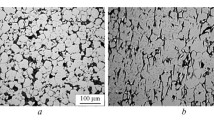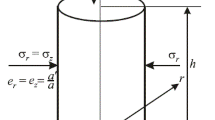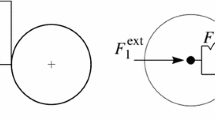Rheological models of deformable bodies are used to develop a dynamic approach to the problem of mechanical actions on porous bodies during pressure sintering. Solutions of dynamic systems describing the force acting on porous viscoelastic bodies, either strain-hardenable or not, are presented depending on the control parameters of the systems. These parameters are determined by the inertial properties and rigidity of the machine and the rheological properties of the deformable bodies. The intensity of densification during the pressure sintering of porous bodies mainly depends on the ratio of rigidity of the system to the viscous resistance of the body. The simulation and analysis of the pressure sintering of porous bodies using the obtained solutions enable prediction of their densification conditions and functional properties depending on the machine characteristics and the sizes and rheological properties of deformable bodies.




Similar content being viewed by others
References
M. Reiner, Phenomenological macrorheology, in: F. R. Eirich (ed.), Rheology. Theory and Applications, Vol. 1, Academic Press, New York (1956), pp. 9–62.
B. Jaoul, Etude de la plasticité et application de métaux, Dunod, Paris (1965).
T. D. Shermergor, Theory of Elasticity of Microinhomogeneous Materials [in Russian], Nauka, Moscow (1977).
K. L. Johnson: Contact Mechanics, Cambridge Univ. Press, Cambridge (1985).
M. S. Kovalchenko, “Dynamics of mechanical actions on materials,” Powder Metall. Met. Ceram., 32, No. 7, 596–601 (1993); 32, No. 8, 662–668 (1993); 32, No. 9–10, 756–762 (1993); 32, No. 11–12, 869–875 (1993); 36, No. 3–4, 217–225 (1997); 37, No. 3–4, 196–203 (1998); 37, No. 5–6, 307–315 (1998); 38, No. 9–10, 505–510 (1999); 38, No. 11–12, 625–637 (1999).
M. S. Kovalchenko, “Dynamics of uniaxial tension of a viscoelastic strain-hardening body in a system with one degree of freedom,” Problems of Strength, 30, No. 4, 364–373 (1998); 30, No. 5, 460–471 (1998); 32, No. 1, 27–40 (2000).
H. L. Lamb, Hydrodynamics, Cambridge Univ. Press (1932).
G. A. Korn and T. M. Korn, Mathematical Handbook for Scientists and Engineers. Definitions, Theorems, and Formulas for Reference and Review, McGraw-Hill Book Company (1968).
A. Angot, Complements des mathématiques. A l'usage des ingenieurs de l’electrotechnique et des telecommunications, Paris (1957).
V. A. Ditkin and A. P. Prudnikov, Integral Transforms and Operational Calculus, Pergamon Press, New York (1965).
M. S. Kovalchenko, “Elasticity and viscosity of isotropic porous materials,” Powder Metall. Met. Ceram., 42, No. 1–2, 81–87 (2003).
M. S. Kovalchenko, “Strain hardening of a powder body in pressing,” Powder Metall. Met. Ceram., 48, No. 3–4, 133–144 (2009).
M. S. Kovalchenko and A. V. Laptev, “Dynamics of WC–Co hard alloy compaction with hot pulsed pressing,” Powder Metall. Met. Ceram., 43, No. 3–4, 117–126 (2004).
M. S. Kovalchenko and L. F. Ochkas, “Densification dynamics of copper and iron powder billets in hot shock compaction: Simulation and analysis,” Powder Metall. Met. Ceram., 47, No. 5–6, 273–283 (2008).
M. S. Kovalchenko, T. P. Hrebenok, and L. F. Ochkas, “Simulation of the compaction dynamics of Cu+Al2O3 powder mixture under impulse hot pressing,” Powder Metall. Met. Ceram., 49, No. 11–12, 637–646 (2010).
M. S. Kovalchenko, “Pressure sintering of powder materials,” Powder Metall. Met. Ceram., 50, No. 1–2, 18–33 (2011).
J. Weertman, “Theory of steady-state creep based on dislocation climb,” J. Appl. Phys., 26, No. 10, 1213–1217 (1955).
Author information
Authors and Affiliations
Corresponding author
Additional information
Translated from Poroshkovaya Metallurgiya, Vol. 52, No. 1–2 (489), pp. 11–28, 2013.
Rights and permissions
About this article
Cite this article
Kovalchenko, M.S. Rheological models of pressure sintering of powders. Powder Metall Met Ceram 52, 7–19 (2013). https://doi.org/10.1007/s11106-013-9490-1
Received:
Published:
Issue Date:
DOI: https://doi.org/10.1007/s11106-013-9490-1




